
From Evolution Theory to a New Creation Theory -- Errors in Darwinism and a Proposal from Unification Thought

Under the Supervision of Sang Hun Lee
|
|
From Evolution Theory to a New Creation Theory -- Errors in Darwinism and a Proposal from Unification Thought |
|
|
|
Under the Supervision of Sang Hun Lee |
I. The Path to the Contemporary Theory of Evolution
1. Aristotle's View of Nature and the Christian Theory of Creation Species are eternally unchangeable.
Aristotle (384 - 322 B.C.), a philosopher of ancient Greece, was the first ever to create systematic biology. He regarded nature as purposive, stating in The Physics,
If, then, artificial processes are purposeful, so are natural processes too; ... we find that plants too produce organs subservient to their perfect development-leaves, for instance, to shelter the fruit ... Hence, if it is by nature and also for a purpose ... that plants make leaves for the sake of the fruit and strike down (and not up) with their roots in order to get their nourishment, it is clear that causality of the kind we have described is at work in things that come about or exist in the course of Nature. (Aristotle, The Physics, 173 -75)
Aristotle considered that nature is ordered from the lower to the higher, ranging from nonliving beings, to plants and animals, all the way to humans. For him, the order of nature is the following; nonliving beings- lower plants-higher plants sponges, jellyfish shellfish - insects -- crustacea cephalopoda -- ovipara - whales • ovoviviparous quadrupeds -- humankind. These are the "steps of nature," or the "hierarchy of nature" (see Figure 1).
It is said that this classification of nature became the model for later thinking on evolution. However, Aristotle regarded the classes of nature as unchangeable, just as, for him, the universe was unchangeable; therefore, the idea of evolution of living beings-that is, the idea that one species of living beings gradually changed into another-did not come to his mind at all.
Eventually Aristotle's view of the universe and nature combined with Christianity. The hierarchy of living beings was regarded as coming from God and as something absolutely fixed. In the Christian view, God, when creating the universe, created every living being "according to its kind," and all the species created by God were eternally unchangeable from the very beginning of the universe. The combination of the Aristotelian view of nature with Christian theory ruled the Western world until the modern period.
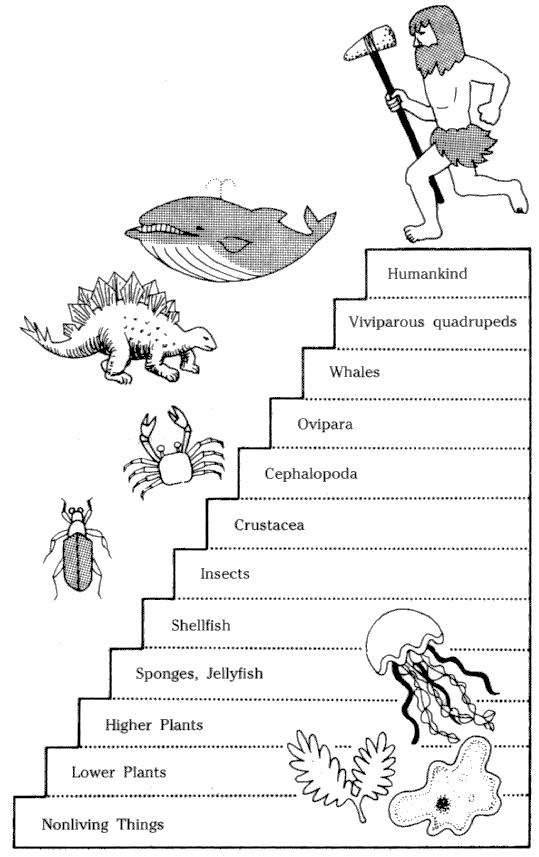
Fig. 1: Aristotle's Steps of Nature
2. The Classification of the Living Beings by Linne: God allowed him to look into the secret shelves of specimens.
The Swedish Carl von Linne (1707-1778), the founder of natural history, inherited the combination of Aristotelian and Christian traditions and believed that the God-created fundamental species of living beings were unchangeable. He said he was grateful that God had allowed him to look into the secret shelves of specimens, and dedicated his life to the task of describing and classifying all the species. He expressed the results of his research in The System of Nature (1735), a small booklet which, over the period of several decades, developed into a work consisting of several volumes.
Linne considered species to be a group of individuals with mutual resemblances, just as children resemble their parents, and that there were as many species as God had created in the beginning. He recognized, however, that even in a particular species of plants some flowers had different colors, or had double flowering, and that slight differences occurred depending on such conditions as climate, land, and nutrition; he termed such species "varieties" (hybrids). Linne's view was that God has indeed created all the species but, having done so, does not interfere with the details of nature, and that varieties are formed through hybridization.
Linne roughly classified living beings into "classes," each class into "orders," each order into "genera," and each genus into "species." He also established a "binomial nomenclature," whereby each living being was given a double name, that is, its genus and species. With further development in science, Linne's artificial classification evolved into a natural classification.
3. Lamarck's Theory of Evolution
Living beings develop from lower to higher stages.
In the seventeenth century, with the rise of the philosophy of the Enlightenment, which emphasized the concept of progress, there arose the idea of the evolution of living beings. In the eighteenth century, that idea expanded with inputs from the French thinkers G. Comte de Buffon, P. M. de Maupertuis, and D. Diderot. A clear statement of the theory of evolution of living beings was put forward when Jean Baptiste de Lamarck (1744 -1829) published his Philosophy of Animals in 1809. Lamarck explained, on the basis of facts, that living beings evolve from lower to higher stages. For Lamarck, the life force inherent in living beings is the element that brings about evolution; through that life force, living beings develop from simple to complex, which brings about irregularity (variety) among them. Further, he said, living beings have the ability to give rise to organs in accordance with, and in conformity to, environmental conditions. Thus he set forth two principles of evolution, as follows (see Fig. 2)
i) Theory of Use and Disuse
In an animal that has not yet reached its final stage of development, the more frequently and constantly an organ is used, the more it strengthens itself, develops, increases in size, and gains power, in proportion to the period of its use. On the other hand, if an organ is not used on a regular basis, it will treacherously weaken, decline, decrease in function, and finally disappear.
ii) Theory of the Inheritance of Acquired Characteristics
Any character that an individual has acquired through preferential use or has lost through continuous disuse of an organ due to the effect of circumstances to which the individual has been exposed for a long time, will be transmitted through inheritance to the new individuals born from it, provided the change is common to both male and female.
The ancestors of giraffes had a short neck, but they had the habit of eating leaves high up on the trees.
As they reached for high leaves their necks become longer.
The character of longer neck was passed on to their descendants, making a long-necked giraffe.
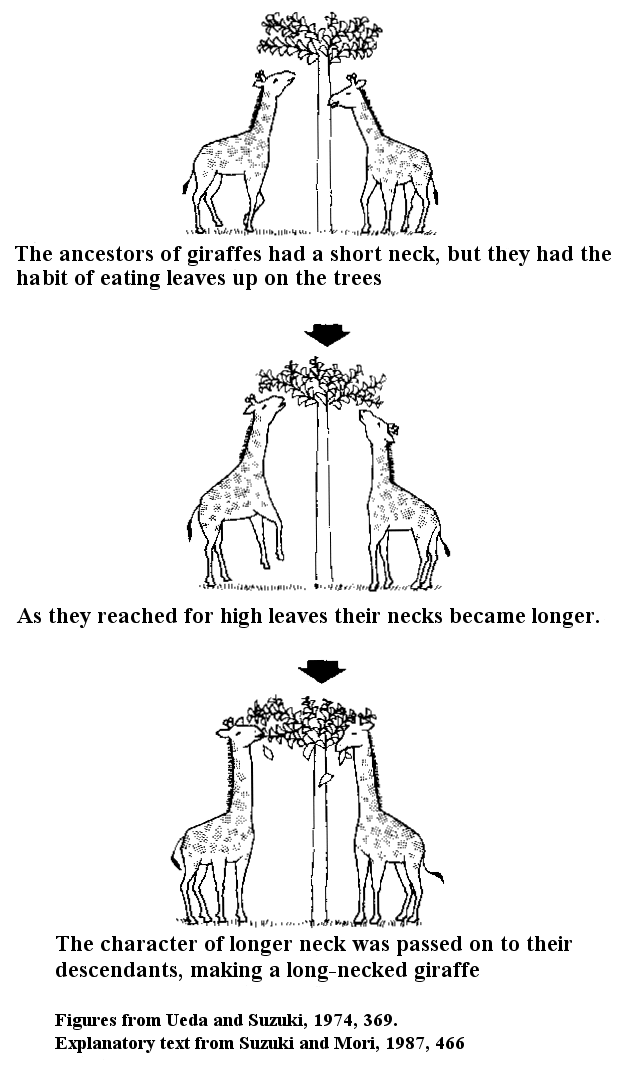
Fig. 2: Explanation of the Long Neck of Giraffes Based on the Theory of Use and Disuse
The above-mentioned assertion by Lamarck could be summarized as follows: Living beings originally develop in a progressive manner from simple to complex; and by doing so, they have become diversified as we see them today, according to the theory of use and disuse and the theory of the inheritance of acquired characteristics.
4. Darwin's Theory of Natural Selection
The struggle for existence in nature selects the species.
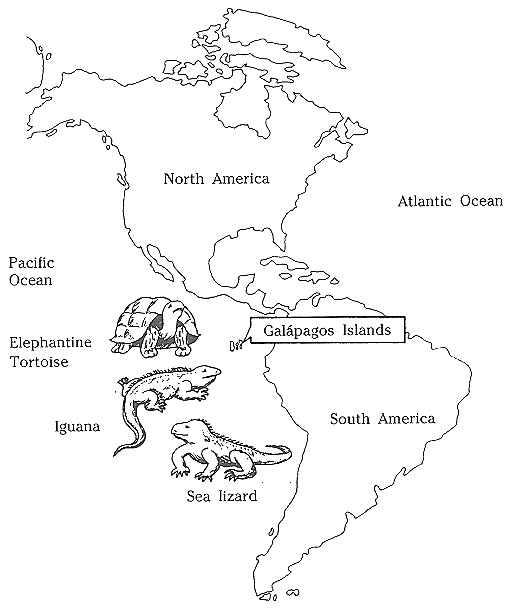
Fig. 3: Location of the Galapagos Islands
The English natural historian Charles Darwin (1809-1882), who in his youth studied in a theological seminary at Cambridge University, became interested in natural history, and upon graduation, went on board of the British Navy's survey ship H.M.S. Beagle. Darwin conducted intense observations on geological features, plants, and animals and became convinced that living beings evolve. His observations at the Galapagos Islands (see Fig. 3) are especially credited with providing him with clear evidence for his views on evolution.
Darwin, who grappled with the issue of "species undergoing change," contrasted how animals and plants would change in a situation where they were growing naturally and in a situation where they were being raised by people. He examined the way plant breeders did their work, and concluded that the key element lay in selection. Breeders artificially selected species for several generations, saving those they considered appropriate and discarding the one they considered inappropriate for their purpose. Darwin took notice of this "artificial selection."
In nature, however, there is no such a thing as a breeder engaging in selection-and that was a problem for Darwin. But T. R. Malthus (1766 -1834) gave him a clue on how to solve that problem. Malthus said that, if it were not for the influence of wars, starvation, and disease, this world would now be overflowing with people; thus, he described the reality of struggle in human society. This view suggested to Darwin the idea that it is the "struggle for existence" that causes the selection of species in nature. That idea developed into what later became Darwin's "theory of natural selection." The points of that theory can be summarized as follows (see Fig 4)
i) There are individual variations among living beings; even among siblings born of the same parents, there are some variations.
ii) Individuals transmit their variations to their descendants.
iii) The number of living beings increases in geometric progression; the supply of food and shelter is limited; therefore, there occurs a struggle for existence between individuals of the same species.
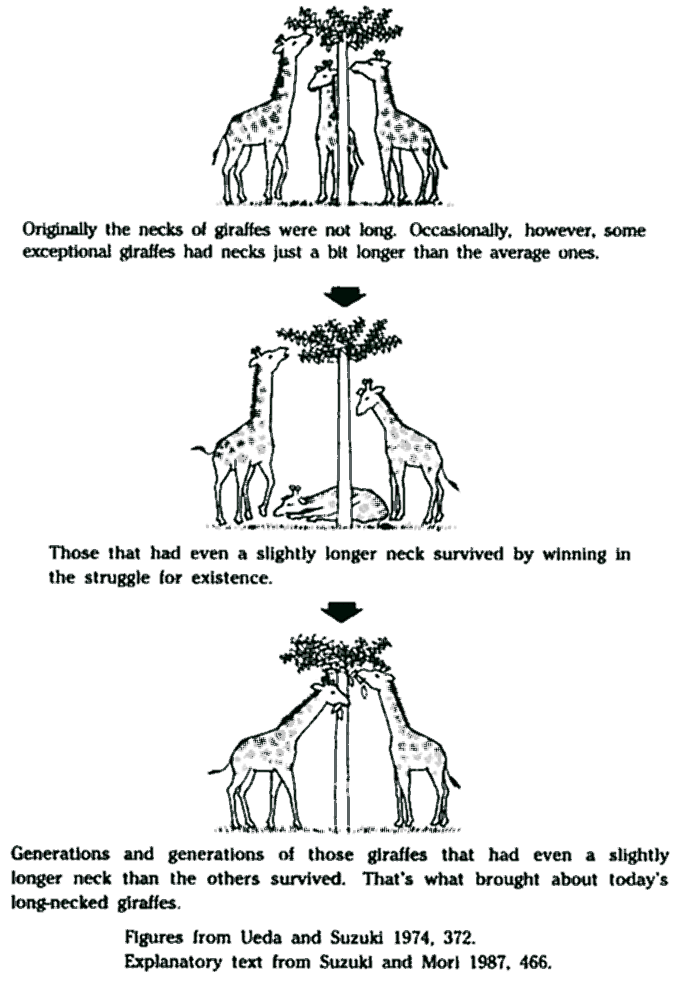
Fig. 4: Explanation of Why Giraffes have Long Necks, according to the Theory of Natural Selection
iv) As a result of struggle for existence, "natural selection" is at work in nature, allowing to survive only those individuals that are suitably adapted to the environment This is called "survival of the fittest."
Darwin disclosed the results of his research in On The Origin of Species, published in 1859. His basic position was that, it is not some kind of "inherent ability" in living beings that allows them to evolve, as Lamarck had said; but rather, it is the natural environment itself that causes them to evolve. As a result, there was no room at all left for any kind of involvement on the part of God in the development of living beings.
Darwin's idea was that, since natural selection works gradually, through a slow accumulation of profitable variations, there is never a huge leap in the evolutionary process of living beings, but rather, living beings evolve slowly and gradually. That idea was in keeping with the old saying that "natura non facit saltum" ("Nature does not do leaps").
As a supplement to his theory of natural selection, Darwin also included "sexual selection," whereby those characteristics that are charming to the opposite sex are selected and preserved. Manes in lions, horns in deer, beautiful feathers in birds were cited as examples of the working of sexual selection.
On the other hand, Darwin accepted Lamarck's view that living beings adapt themselves to changes in the environment, and in doing so, change themselves. Considering that profitable variations in individuals that have survived by natural selection were hereditary, Darwin also accepted what Lamarck called "inheritance of acquired characteristics."
Later, the German biologist August Weismann (1834-1914) published the results of an experiment in which he consistently cut the tails of mice one generation after another, for 22 generations. He observed that the offspring of those mice were not at all born with shortened tails. Based on that, he totally denied Lamarck's "inheritance of acquired characteristics" and advocated, instead, evolution based only on natural selection alone. His position came to be known as "Neo-Darwinism."
5. Mendel's Discovery of the Laws of Heredity
His experimentation with peas eventually gave rise to genetics.
Darwin established the idea of the evolution of living beings; but, with regard to such issues as how the characteristic features of living beings are transmitted from parents to descendants and how a change in a living being occurs, he did not have very clear ideas. However, while Darwin was writing On The Origin of Species, a monk named Gregor Johann Mendel (1822-1884) was experimenting with plant crossings in his monastery in Austria, in search of the laws of heredity.
Mendel's experiment consisted in crossing various kinds of peas. After gathering results for eight years, he established three basic laws of heredity, namely, the "law of dominance," the "law of segregation," and the "law of independence" (see Fig. 5).
i) The Law of Dominance
Mendel first crossed wrinkled peas with round peas. The peas grew, and when he opened the shells of the crossed peas, he found only round peas, neatly lined up side by side; there were no wrinkled peas. Thus, in the first generation of crossing, one of the characters became dominant (the round peas), and the other became recessive (the wrinkled peas) -and only the dominant character appeared. In this way, he discovered that, among opposing characters, only the dominant one will appear in the first generation of crossing. This is the law of dominance.
ii) The Law of Segregation
Next, through self-pollination of the first generation of the crosses, the second generation of the crosses was made. When the shells were opened, both round and wrinkled peas were found. When they were counted, the ratio was three round ones to one wrinkled.
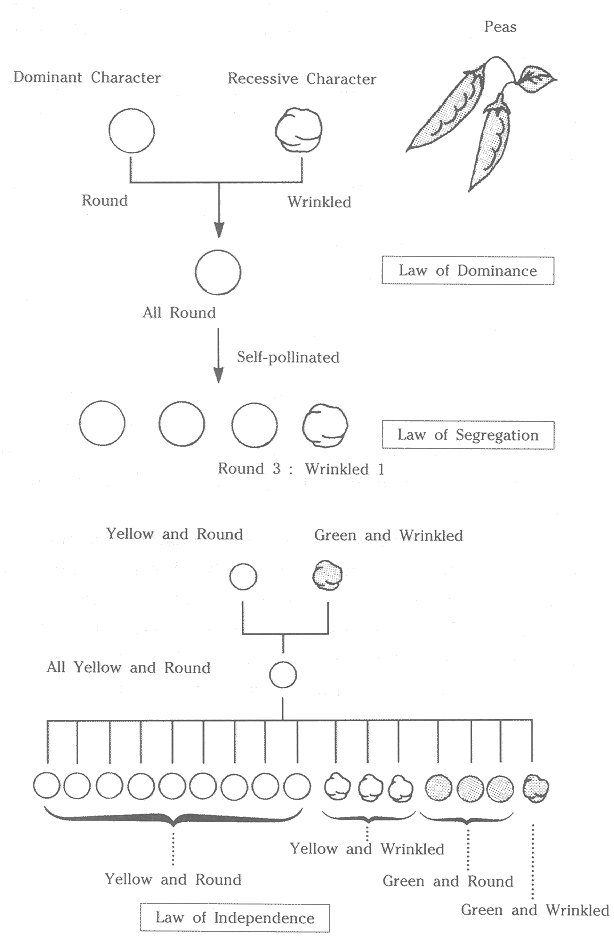
Fig. 5: Mendel's Laws of Heredity
If we express the dominant character as A and the recessive character as a, then the only combination made in the first generation of the cross is Aa; but in the second generation (the result of combining Aa with Aa), there are three combinations, namely, AA, Aa, and aa, in the ratio of 1: 2: 1. But since A is dominant in Aa, the ratio between A and a turns out to be 3 to 1. This is the law of segregation.
iii) The Law of Independence
In crossing, when two or more pairs of opposing characters are involved (for example, round or wrinkled shape, and green or yellow color in peas), each pair of the opposing characters behaves and is transmitted independently. That is the law of independence.
Mendel quickly comprehended the meaning of those results. He considered that the factor responsible for the manifestation of a character is inherent in the body of a living being; he called it an "element." Mendel's discovery of the laws of heredity gave rise to the science of genetics, and Darwin's theory of evolution came to be explained in combination with genetics.
6. De Vries' Mutation Theory: New species have appeared suddenly.
The Dutch botanist Hugo De Vries (1843-1935) asked the following question: If natural selection is concerned only with small individual variations, then why is there such big differences between one species and another ?
One day, while observing evening primroses in the suburbs of Amsterdam, De Vries noticed a few oddly shaped hybrids mixed among them. He brought them to his university, grew them, and for eight years he observed them. He found that some of them came to blossom normal flowers, while others never lost the characters of hybrids, even after many generations. Thus, De Vries considered that a new variation appears all at once without passing through intermediate stages and attains stability right away; it is hereditary. He named it "mutation" (mutation theory, 1901).
De Vries considered the evolution of living beings as follows: A new species is formed, not gradually under the effect of natural selection, but suddenly through hereditary change.
With regard to new plant hybrids, De Vries noticed that not everything in their shape was changed, as many biologists had expected. Not all was changed, but only one or a few points. Thus he considered that "the characters of living beings consist of clearly distinguishable, independent units." In 1900, De Vries became acquainted with Mendel's work and learned that not he but Mendel had discovered the secrets of heredity.
About the same time, Wilhelm Johannsen (1857-1927), a Danish botanist, advocated the theory of "pure line" (1903), clarifying that individual variations (i.e., continual, small variations among the individuals of the same species), which Darwin considered to be the cause of evolution, are "fluctuations" (i.e., normal, nonheredity variations that arises through the influence of the environment and habit), and are not hereditary. That raised a difficult problem for Darwin's theory of natural selection, which De Vries' mutation theory later solved.
De Vries mutation theory gained the support of many biologists. Later, however, disagreements began to occur between those who supported De Vries' position (mutation theory) and those who supported Darwin's position (evolution through natural selection working on minute, consecutive variations).
7. The Discovery of DNA: The Remarkable molecule of heredity
The element that Mendel and De Vries considered to be inherent within the body of a living being and responsible for the manifestation of its characters was named "gene" by Johannsen.
The American Zoologist Thomas Morgan (1866-1945) conducted research on fruit flies on the basis of Mendel's laws of heredity and De Vries' theory of mutation. Morgan established the "gene theory" (1926), or the view that the characters of an individual are transmitted through arrangements of genes within a cell's chromosomes.
In 1953, the American molecular biologist James Watson (1928- ) and the English physicist Francis Crick (1916- ) clarified that the gene is a molecule of a double helix structure, called DNA. DNA consists of two twisted threads, each made of sugar and phosphoric acid alternately combined, which are mutually bridged by pairs of bases at their parts of sugar. The bases are classified into four kinds: adenine (A), thymine (T), guanine (G) and cytosine (C). Yet, always paired are adenine and thymine, and guanine and cytosine (see Fig. 6).
DNA is indeed the genetic matter directly responsible for heredity in living beings. After the discovery of DNA, issues concerning evolution came to be discussed in relation to DNA.
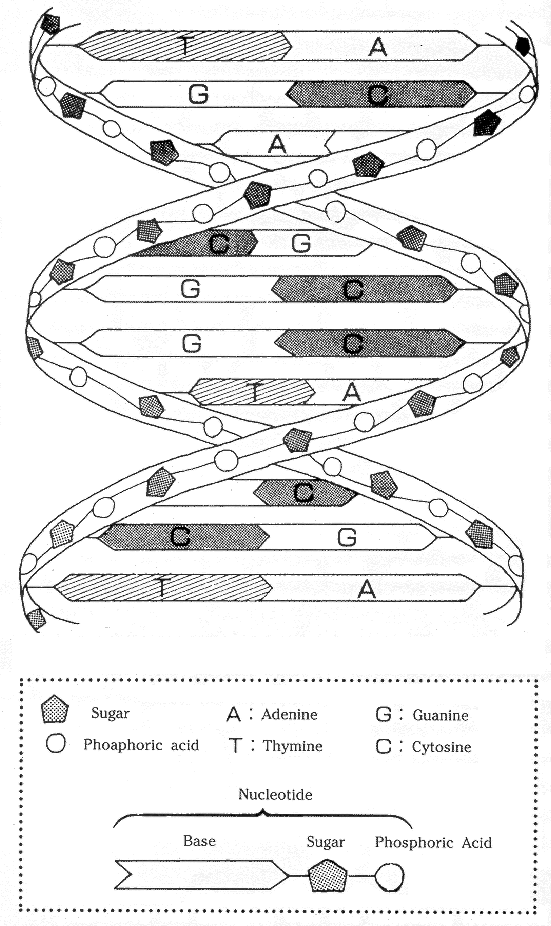
Fig. 6: The Double Helix of DNA
8. The Emergence of the Synthetic Theory
Darwin + De Vries = Synthetic Theory
As a result of research on the mutation of fruit flies conducted by Morgan and his group, it became clear that mutation through genetic change does not necessarily bring about a great leap, or a radical change (see Fig. 7). Therefore, mutation theory and Darwin's theory of natural selection came be seen as not mutually incompatible.
The English statistician Ronald A. Fisher (1890-1962), the British geneticist John B. S. Haldane (1892-1964), and the American geneticist Seawell Wright (1889-1988) analyzed genetic problems by using mathematical models. As a result, they claimed to have found that mutation is not the primary cause of evolution and that the direction and speed of evolution is determined almost completely by natural selection.
Accordingly, a new way of explaining evolution appeared, which combined Darwin's theory of natural selection with De Vries' theory of mutation. The new theory was called "synthetic theory," which is also called "Neo-Darwinism," as was the position of Weismann. But today, the term "New-Darwinism" is used almost exclusively to refer to synthetic theory; "NeoDarwinism" and "synthetic theory" have become virtually synonymous.
Representatives of synthetic theory are the British biologist Julian Huxley (1887-1975), the Russian-born American geneticist Theodosius Dobzhansky (1900-1975), the German-born American animal taxonomist Ernst Mayr, and the American paleontologist George Simpson (1902- ). According to Huxley, who is regarded as the godfather of synthetic theory, evolution can be summarized as follows (Huxley 1963, 44)
i) Mutation provides the raw material for evolution.
ii) Natural selection determines the direction of evolution.
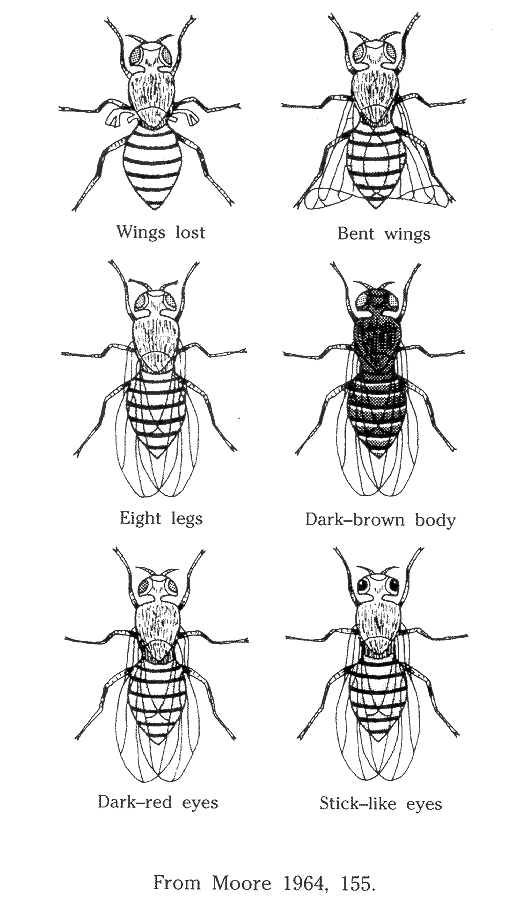
Fig. 7: An Experiment with Mutation in Fruit Flies
Huxley asserted that mutation proceeds in all directions, accidentally and at random, and merely provides the raw material for evolution. Most mutations are harmful to living beings, but a very small number of living beings with an advantageous mutation survive in the struggle for existence, that is, they are selected by nature. As a result, mutations favorable to living beings develop gradually.
Today it is an established theory that the cause of mutation is disorder in the arrangement of the bases of DNA. The French molecular biologist Jacque Monod (1910-1976) suggested the following as the causes of mutation (Monod 1971, 112)
i) The substitution of a single pair of nucleotides for another pair; of nucleotides for another pair (A nucleotide is a unit that composes DNA and consists of base, sugar and phosphoric acid (see fig. 6); a pair of nucleotides is a rung in the ladder of a double helix structure.)
ii) The deletion or addition of one or several pairs of nucleotides; and
iii) Various kinds of "scrambling" of the genetic text by inversion, duplication, displacement, or fusion of more or less extended segments.
The path of evolution theory culminating with the establishment of synthetic theory of the contemporary period can be summarized as in Fig. 8.
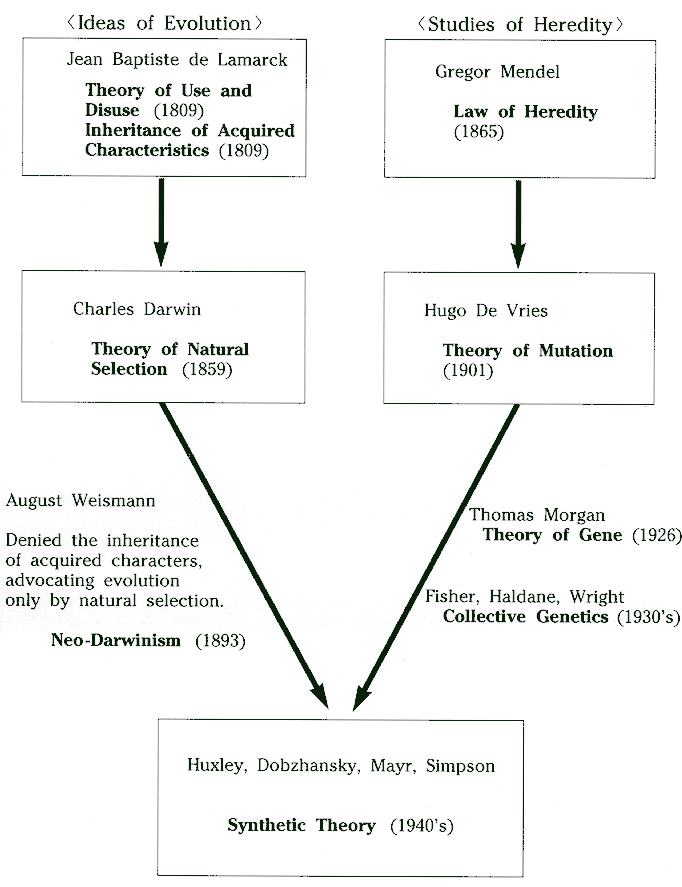
Fig. 8: Summary of the Contemporary Theory of Evolution
Download entire page and pages related to it in ZIP format
Table of Contents
Information
Tparents Home